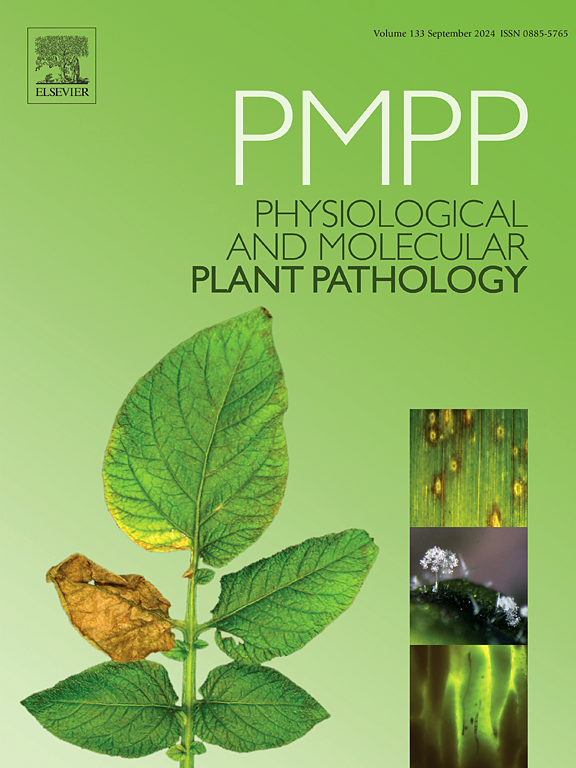Susceptibility of fig cultivars to three fungal pathogens associated with Botryosphaeria canker
IF 2.8
3区 农林科学
Q2 PLANT SCIENCES
引用次数: 0
Abstract
Botryosphaeria canker poses a significant threat to the health and productivity of various woody plants, including edible fig trees, worldwide. This study aimed to evaluate the susceptibility of different fig cultivars to three prominent species of the Botryosphaeriaceae family: Botryosphaeria dothidea, Neofusicoccum parvum, and Neoscytalidium dimidiatum. These well-known canker-causing pathogens were isolated from infected fig trees in northern and western Iran and identified via morphological observations and molecular tools. This is the first global report of B. dothidea as a canker-associated pathogen on fig trees and the first report of N. parvum causing canker disease on fig in Iran. We assessed the susceptibility of 11 drought and/or salinity-tolerant fig cultivars to these pathogens using artificial inoculation of fig saplings. The assessment was based on six pathogenicity characteristics: external and internal lengths and widths of wood discoloration, number of pycnidia (whenever present), and latent period. The external length of wood discoloration was the principal contributor to the first dimension of principal component analysis (PCA), which accounted for 66.6 % of the total variance observed. This result was consistent with the outcome of the analysis of variance (ANOVA) conducted on this variable. Based on their clustering pattern in the PCA graph, as well as their ranking in induced lesion length from Tukey's multiple range comparison, fig cultivars could be classified into susceptible, semi-susceptible, and less susceptible groups. Ficus carica cv. 'Matti' exhibited the least length of wood discoloration and the most extended latent period when inoculated with the three Botryosphaeriaceae species. Among the pathogens, N. parvum was identified as the most aggressive, caused canker and dieback in inoculated fig saplings. The cultivars 'Siah', 'Sabz', 'Gilasi', and 'Dehdez' were susceptible to all three species within the Botryosphaeriaceae family. These findings enhance our understanding of Botryosphaeria fig canker and provides insights for future disease management efforts.
无花果品种对三种与腐烂葡萄球菌相关的真菌病原菌的敏感性
溃疡病对世界各地各种木本植物,包括可食用无花果树的健康和生产力构成重大威胁。本研究旨在评价不同无花果品种对Botryosphaeria dothidea、Neofusicoccum parvum和Neoscytalidium dimidiatum三种Botryosphaeria的敏感性。这些众所周知的引起溃疡病的病原体是从伊朗北部和西部受感染的无花果树上分离出来的,并通过形态学观察和分子工具进行鉴定。这是全球首次报道在无花果树上发现与溃疡病相关的病原菌,也是伊朗首次报道在无花果树上发现引起溃疡病的小乳杆菌。采用人工接种无花果树苗的方法,评估了11个耐干旱和/或耐盐的无花果品种对这些病原菌的易感性。评估基于6个致病性特征:木材变色的外部和内部长度和宽度,犬瘟菌的数量(无论何时存在)和潜伏期。木材变色的外部长度是主成分分析(PCA)第一维方差的主要贡献者,占总方差的66.6%。这一结果与对该变量进行方差分析(ANOVA)的结果一致。根据PCA图中的聚类模式,以及Tukey多范围比较的诱导病变长度排序,可以将无花果品种分为易感、半易感和不易感三类。无花果属植物“Matti”与三种植物接种时,木材变色长度最短,潜伏期最长。在这些病原菌中,小梭菌是最具侵略性的,可引起接种无花果树苗溃疡病和枯死。栽培品种“Siah”、“Sabz”、“Gilasi”和“Dehdez”对这三种植物都敏感。这些发现增强了我们对无花果腐烂葡萄球菌的了解,并为未来的疾病管理工作提供了见解。
本文章由计算机程序翻译,如有差异,请以英文原文为准。
求助全文
约1分钟内获得全文
求助全文
来源期刊
CiteScore
4.30
自引率
7.40%
发文量
130
审稿时长
38 days
期刊介绍:
Physiological and Molecular Plant Pathology provides an International forum for original research papers, reviews, and commentaries on all aspects of the molecular biology, biochemistry, physiology, histology and cytology, genetics and evolution of plant-microbe interactions.
Papers on all kinds of infective pathogen, including viruses, prokaryotes, fungi, and nematodes, as well as mutualistic organisms such as Rhizobium and mycorrhyzal fungi, are acceptable as long as they have a bearing on the interaction between pathogen and plant.

 求助内容:
求助内容: 应助结果提醒方式:
应助结果提醒方式:


